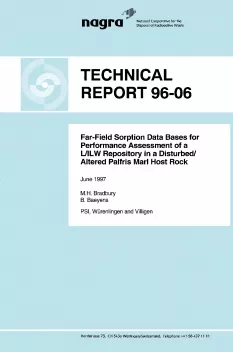
Technical Report NTB 96-06
Far-Field Sorption Data Bases for Performance Assessment of a L/ILW Repository in a Disturbedl Altered Palfris Marl Host Rock
The large quantities of cement/concrete inherent in the current designs for low-land intermediate-level radioactive waste (L/ILW) repositories will interact with the slowly moving deep groundwater and probably give rise to a long pulse of hyper alkaline fluid in the far field. The pH of the plume might remain in excess of 12.5 for tens of thousands of years. Many of the minerals along the flow paths in a sedimentary host rock, with the notable exception of calcite, would be unstable under these conditions leading to dissolution reactions, secondary mineral precipitation and changes in groundwater chemistry. Although it is relatively clear that the most likely types of new mineral phases to form are calcium silicate hydrates (CSH), calcium aluminium silicate hydrates (CASH) and possibly zeolites, the system is very complex and is evolving in time and space. For these reasons the well defined rock mineralogies and water chemistries normally required as a pre-requisite for constructing credible sorption data bases are not available in this case.
The purpose of this report is to attempt to assess the effects of the interactions between a pH plume and Palfris marl on the far-field sorption properties of the formation. Despite the previously mentioned fundamental difficulties, a series of procedures are described in detail whereby it was possible to deduce conservative sorption data bases for altered marl corresponding to the five main mineralogies and two water chemistries characterising the main flow paths in the Palfris marl host rock.
